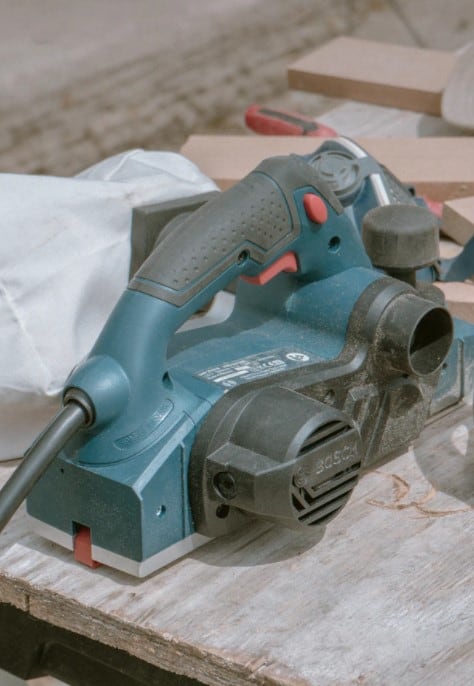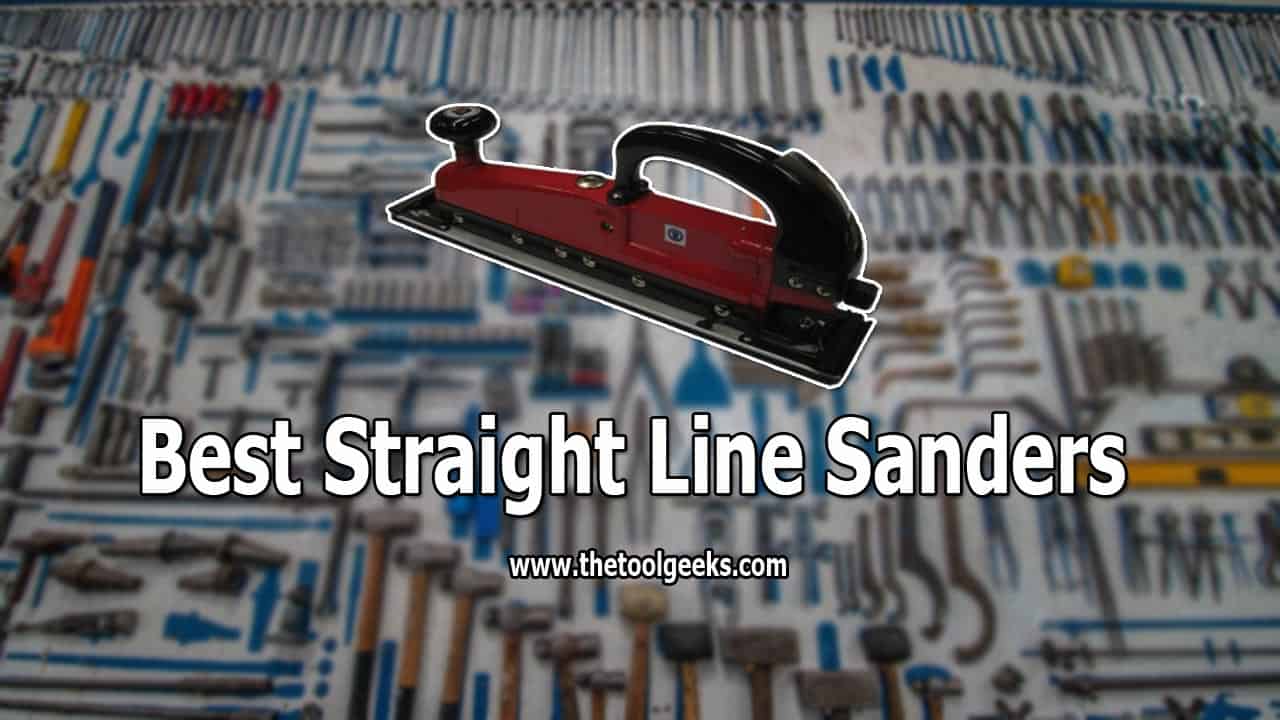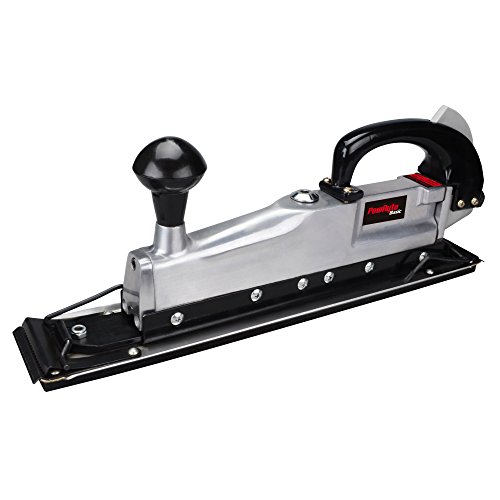Best Straight Line Sanders – Detailed Reviews & Buying Guide
TheToolGeeks.com is a participant in the Amazon Services LLC Associates Program and other affiliate advertising programs. We may earn from qualifying purchases. (Learn More).
On the construction site, in the auto body shop, when renovating your home, or with woodworking, you’ll no doubt need to do some (or a lot!) of sanding. It can be a tough job to do by hand, taking a fair amount of time and likely contributing to blisters and sore muscles. While orbital and belt sanders are the most popular types of sanders, today, I’d like to introduce you to straight-line sanders, which can help reduce your work time, save your body some wear-and-tear, and complete your project faster.
Jump To Page Contents:
What is a straight-line sander?
Straight-line sanders are pneumatic, or air-powered, sanders with a long, thin sanding block that moves in a back and forth, straight motion. They have been used in auto body shops, industrial facilities, and construction sites but can also be used in the home or woodshop. They may also be called inline or longboard sanders.
These sanders are mostly used on surface areas where hand sanding is challenging or time-consuming, and projects that have complex edges or tighter spaces. They are ideal for polishing a wide range of materials including wood, steel, fiberglass, and sheet metal, as well stripping paint, and smoothing both flat and non-flat surfaces.
Straight-line sanders use one or two pistons that are driven by compressed air to move the sanding block. Various types of sandpaper and sheets can be attached to the sanding pad, depending upon the material with which you are working. They are handheld, for either one or both hands, and many have a main handle plus a second control knob.
Since they are air-powered, they require a separate air compressor. But they work well as a powerful, time-saving air tool to add to your collection if you already have a compressor. Plus straight-line sanders can work with different compressors and varying CFM ranges, depending upon your budget.
Choosing the right straight-line sander is key. To help you make the best choice, I’ve gathered together a list based upon experience and research that features the five best straight-line sanders on the market today. I’ll show you the top features to look for, different sander models available, and the price ranges for each model.
If you are already familiar with straight-line sanders, then here’s my recommended list. And for more information, keep reading for detailed reviews of each one and for the buying guide.
Best Straight Line Sanders – My List
| Products | Product Name | Details | Price |
|---|---|---|---|
Dual Piston | Dual Piston |
| Buy On Amazon |
Industrial-Grade | Industrial-Grade |
| Buy On Amazon |
No Rolling Gear | No Rolling Gear |
| Buy On Amazon |
Portable | Portable |
| Buy On Amazon |
Budget-Friendly | Budget-Friendly |
| Buy On Amazon |
2nd Budget Pick | 2nd Budget Pick |
| Buy On Amazon |
Best Straight Line Sanders – My Reviews
1. Ingersoll Rand 315G – Popular Air Sander
- Robust power
- Variable speed
- Comfortable and easy-to-use
More detailed review ↴
Ingersoll Rand is a top-line brand to consider when selecting a straight-line sander for your job. The brand has been making tools for several years, and all of their products are high-quality and durable. The Ingersoll Rand 315G non-rotary air sander is no exception.
The Ingersoll Rand 315G is an air sander that comes with dual-piston, giving the tool enough power to deal with all types of surfaces. Like most straight-line sanders, the 315G comes with 3000 SPM, and has enough speed to take the smooth out and flatten even the roughest surfaces. The sander is well-suited for professional construction work and more day-to-day sanding tasks.
On the downside, this is a heavy tool. However, if you have worked with heavy tools previously, you won’t have any issues with the Ingersoll Rand 315G. This straight-line sander also vibrates a lot (but this doesn’t impact performance). And its rubber knob grip reduces the effect of vibrations and makes your sanding experience more comfortable.
Pros:
- Powerful – The dual-piston design gives the tool power and prevents stalling.
- Quick – The sander has variable speeds, reaching all the way to 3000 SPM.
- Smooth finish – The 315G can smooth out and give a flat finish to just about any surface.
- Comfortable – The ergonomic grip and rubber knob make this sander easy to handle.
- Weight – The sander is heavy and may be difficult for some tasks.
- Vibration – It vibrates a lot, which may result in less efficient work for people unfamiliar with tools like the 315G.
2. Chicago Pneumatic CP7268 – Best Air-Powered Straight Sanders
- Lightweight
- Guard Protection
- Comfortable Handle
More detailed review ↴
The Chicago Pneumatic CP7268 is a perfect tool for beginners and DIYers, and one of the Best Air-Powered Straight Sanders.
Light-weight design is a big bonus and differentiator for the Chicago Pneumatic CP7268. Made of high-quality aluminum, the Chicago Pneumatic weighs in at approximately 6 pounds—making it a lightweight yet durable choice in straight-line sanders. Built for efficiency, the Chicago Pneumatic is also designed for long-time use and performance, without becoming fatigued.
This straight-line sander comes with a twin-piston mechanism, giving it enough power to remove materials from any surface. It’s an excellent choice for fast sanding and surfacing, like leveling bumps or dings in the panels on your car or truck. Reaching a speed of 3000 SPM means it won’t leave swirl marks, either.
The guard protection is a key detail of the Chicago Pneumatic. An important safety protection, this key feature helps protect your fingers (a bonus for beginners). When tackling jobs that require lots of scrubbing or smoothing fillers, users will appreciate the cushioned pad.
Something to be aware of with the Chicago Pneumatic: Extended usage can cause the straight-line sander to heat up, reducing its performance capacity.
Pros:
- Lightweight and durable – The Chicago Pneumatic is a long-life tool, portable, and durable.
- Material removal – This straight-line sander is an ideal tool for fast material removal.
- Fast – Speeds can reach as much as 3000 SPM.
- Safe usage – A helpful guard protector keeps your fingers and hand comfortable and safe.
- Overheating – The Chicago Pneumatic can overheat, causing a drop in performance and results.
3. Hutchins HUT2000 – Best Inline Sanders
- No Rolling Gear
- Portable
- Forceful
More detailed review ↴
The Hutchins HUT2000 straight-line sander is the most expensive, high-end sander on our list. If you are looking for a straight-line sander that provides top-quality results and smooths and flattens surfaces effectively—this sander is for you.
The Hutchins HUT2000 comes with a double rack-and-pinion gear assembly, allowing the sander to contact the surface twice—helping the tool work in perfect balance. Much like the Chicago Pneumatic, this straight-line sander is lightweight, too; weighing in at roughly 7 pounds.
What makes the Hutchins HUT2000 sander different from the others listed here is that it comes without rolling gears. No more unexpected jumping or jerky motions when the reciprocating stroke ends. The 2-in-line cylinder gives the piston more power and is micro-honed to prevent cylinder wall drag, too. This device boasts a speed of 3000 SPM and is highly recommended for professional use.
The only drawback to the Hutchins HUT2000 is that it tends to stop working after a few hours, so you have to wait a few seconds before using it again.
Pros:
- Well-balanced – The Hutchins HUT2000 doesn’t jump after each stroke.
- Smooth performance – The tool has low-level vibrations and slides smoothly when sanding surfaces.
- Powerful – The 2-in-line cylinders give the piston more power.
- Superior quality – This straight-line sanding option is a high-grade, top-quality product from a trusted brand in the industry.
- Expensive – It is quite costly for layman use.
- Break off – It tends to stop often.
4 . Astro 888S – Best Longboard Air Sander
- Portable
- Lightweight
- Trigger Location
More detailed review ↴
If you are looking for a portable straight sander that you can easily carry around then you should check the Astro 888S. What makes this device special is its size and its weight.
This one is a lighter sander as it weighs approximately 4 pounds, making it very easy to control. The weight also helps you to work long hours without getting fatigued.
Although this unit comes with only one piston, still it comes with a speed of 3000 SPM, which is enough to deal with most surfaces. The trigger is located at the bottom of the handle, making it very easy to push even if you are in a fast sanding job.
On the downside, it doesn’t come with paper clamps to hold the sandpaper.
Pros:
- Portable – You can easily carry it around due to its size.
- Lightweight – Approximately weighs 4 pounds
- Speed – Comes with a speed of 3000 SPM.
- Stop Trigger Release- You can easily press it.
- One Piston
- Doesn’t come with paper clamps
5. PowRyte Basic 100111 – Best Airblock Sander
- Budget-Friendly
- Made of Metal
- Easy to Use
More detailed review ↴
If you are looking for an affordable straight line sander that will do its job then you should check PowRyte Basic 100111.
This straight sander is used by homeowners a lot — the main reason for that is the affordable price and its performance. This unit comes with a two-piston design that delivers up to 3000 SPM.
Another great thing about this straight sander is its construction and weight — it is made of metal which makes this unit very durable and approximately weighs 5 pounds, making it lightweight yet durable.
This sander will do a pretty good job if it’s used only for small projects. We don’t recommend using it for larger projects and long hours.
Pros:
- Budget-friendly — You don’t have to spend a lot of money.
- Easy to use – This unit is very easy to use.
- Lightweight – Approximately weighs 5 pounds
- Durable – Its body is made of metal
- Speed – 3000 SPM.
- Not recommended for heavy projects.
6. ATD Tools 2181 Straight-Line Air Sander
- Study Design
- Two-handle design
- Reliable power
More detailed review ↴
The ATD Tools 2181 Inline/Straight-Line Air Sander is a budget-friendly but well-constructed sander. Its inline design makes this all-in-one tool ideal for any straight-line operation providing up to 40% more material removal than a conventional drum-style sander.
The ATD 2181 is great for use on large flat surfaces. It comes with a durable aluminum housing designed to handle vibration during operation. The case also protects users from dust particles, common with a non-powered sander.
The dual pistons on the ATD 2181 can generate efficient power up to 2300 SPM, allowing you to finish work in less time. The sander has spring clamps that assist in easy sandpaper changes and quick action.
Pros:
- High-quality – It is of good quality with sturdy construction, making it a durable sander.
- Balanced – The two-handle design allows easy balance while operating.
- Lightweight– It is the lightest straight-line sander that I have listed at 2.4 pounds.
- Non-flexible speed – It lacks variable speed control, which limits what jobs it can be used to tackle.
Inline Sanders — Buyers Guide
Straight-line sanders can be more complicated than other basic sander models. With a wide variety of features, it can be tricky to figure out which one is best for you and your job.

Today’s market of straight-line sander includes not just top models, but some hard-to-spot copycats and lower-quality choices, too. To help you figure out what options are best for you, we’ve pulled together the following shopping guide. Learn about key features to help you make sure the sander you purchase is perfect for your job.
Usage
To get the best tool possible, you need to know the project type. This information alone will inform which sander features you’ll want to look for. If you know an inline or straight-line sander is what you’re looking for—not a sheet sander or orbital sander.
Read More — Best Triangle SandersPiston
Straight-line sanders use a piston or cylindrical part that moves back and forth. The piston’s energy is what helps propel the sander and give it motion and movement.
Air-powered straight-line sanders can come with a single-piston or double-pistons. One piston sander is enough if you are working on a small project. (It also costs less.)
If you’re going to be working on larger projects, you’ll want to consider a dual-piston sander. The two pistons make the sander more powerful. (But, they tend to be more expensive.)
Read More — Best Battery Powered SanderSpeed (SPM)
The speed of straight-line sanders is measured with SPM (strokes per minute). One stroke counts when the sander plate does a full movement (back and forth). The more SPM the sander has, the faster it is.
Faster straight-line sanders are preferred and will help you complete the project in less time, and with less residue build-up.
You’ll want to get yourself a straight-line sander that comes with at least 3000 SPM.
Read More — Best Metalworking SanderWeight
Most sanders can be hard to handle, large, and uncomfortable. Plus, more power sanders tend to move very fast. To avoid fatigue, lightweight sanders are recommended.
If your job will require you to work for a long period at a time, choose a lightweight sander.
Read More — Best Pole SandersSafety
No matter if you’re a professional contractor or a DIYer, you should always check to ensure the power tool that you’re buying is as safe as possible.
Some of the key features possessed by the industry’s safest tools include ergonomic grips, guards, and reduced vibrations.
In addition to buying safe tools, you should also protect yourself, the people around you, the surface you are working on, and the tool.
Here are a few safety precautions to consider:
- Wear safety equipment — Straight-line sanders produce a lot of dust, so it’s important to wear a mask, goggles, and gloves to protect yourself.
- Read the manual — Each sander comes with different features. Read the manual to know exactly how your tool operates, before using it.
- Ventilation — Take care in positioning yourself in a well-ventilated work area. Avoid closed areas. Proper ventilation is necessary because a large amount of dust is produced.
- Maintain the sander — You should always clean and check the sander before and after each use. A good tip: If you maintain the tool, then it will last longer.
Why should you use a straight-line sander?
Straight-line sanders are used to give different surfaces a smooth finish. You can use them on wood, steel, glass, metal, etc.
They are mostly used by professionals, but they can be helpful for DIYers too. Basically, they are used in places where hand sanding isn’t possible.
Here are some features that make the straight-line sanders unique:
Double Piston
There is a huge difference between single-piston straight-line sanders and dual-piston sanders.
- One-piston sanders are used for small projects because they don’t have high power or speed.
- Double-piston sanders are more powerful and fast. They also are more stabilized.
We recommend buying a straight-line sander with a two-piston arrangement.
Read More — Best Sander For PalletsComfortable Handle
When looking at straight-line sanders, pay close attention to the handle. This is a critical part of any tool’s design and contributes directly to the tool’s effectiveness and control.
Most straight-line sanders come with a comfortable, ergonomic grip.
Sanding Width
The main reason people use straight-line sanders is to save time. Another bonus is the width of the sander. A wider sanding surface means even less time is needed to finish the job.
If you’re considering a wider straight-line sander, make sure that its size and dimensions match your job. You don’t want to buy a larger sander, only to discover later it can’t reach into the spots you need to sand.
Learn More — How to sand Glass?Final Words and My List Again
A good straight-line sander can be what makes or breaks your home renovation timeline. Good sanders will help you complete the process faster and do it better.
We hope our product reviews and buying guide helps you quickly identify the right straight-line sander to fit your job.
Now that you’ve read our post, share your comments below. Have you used one of the sanders mentioned here? Tell us more about why you liked it? Or, if you have questions—let us know!
| Products | Product Name | Details | Price |
|---|---|---|---|
Dual Piston | Dual Piston |
| Buy On Amazon |
Industrial-Grade | Industrial-Grade |
| Buy On Amazon |
No Rolling Gear | No Rolling Gear |
| Buy On Amazon |
Portable | Portable |
| Buy On Amazon |
Budget-Friendly | Budget-Friendly |
| Buy On Amazon |
2nd Budget Pick | 2nd Budget Pick |
| Buy On Amazon |
Amazon and the Amazon logo are trademarks of Amazon.com, Inc, or its affiliates.













